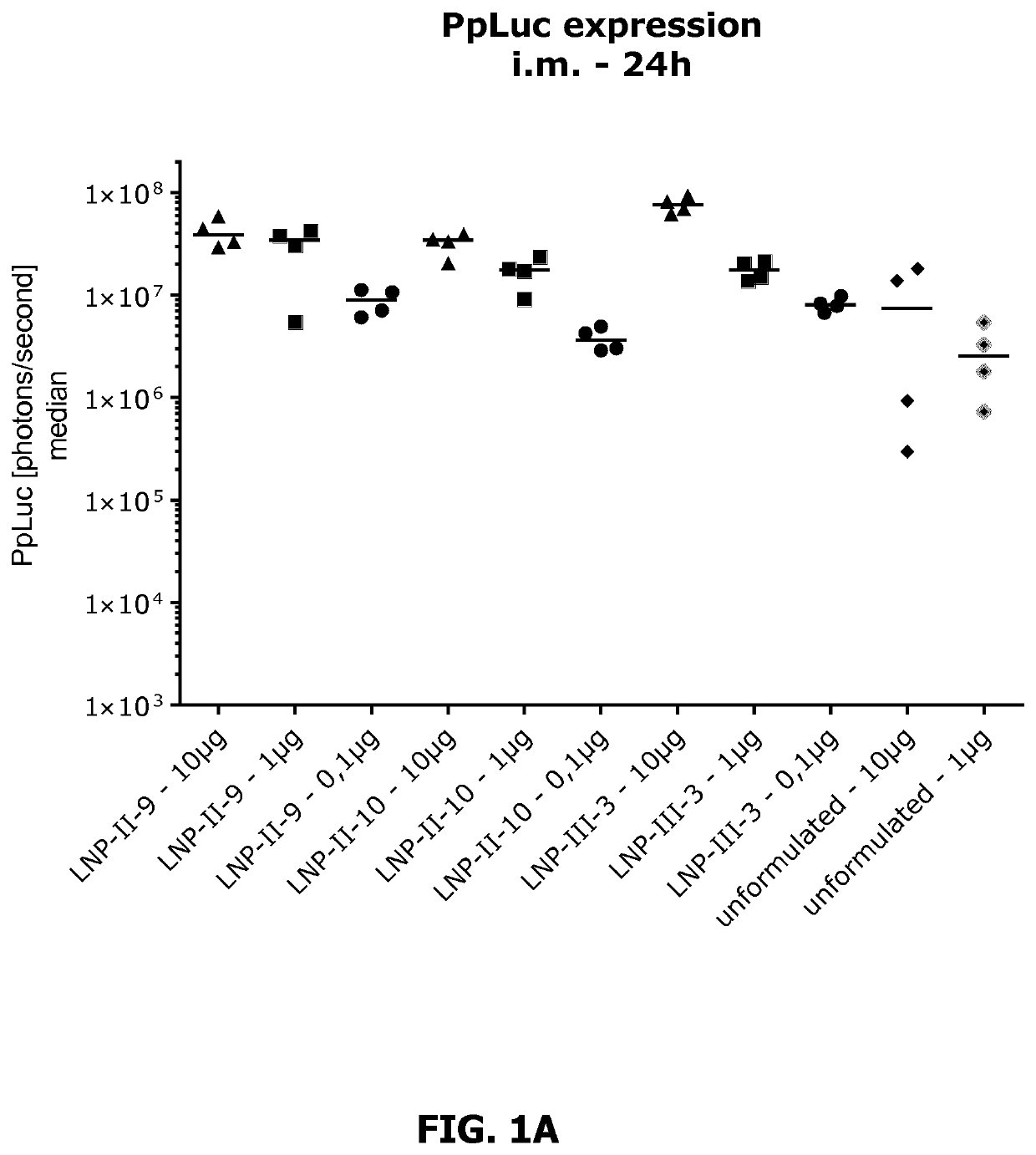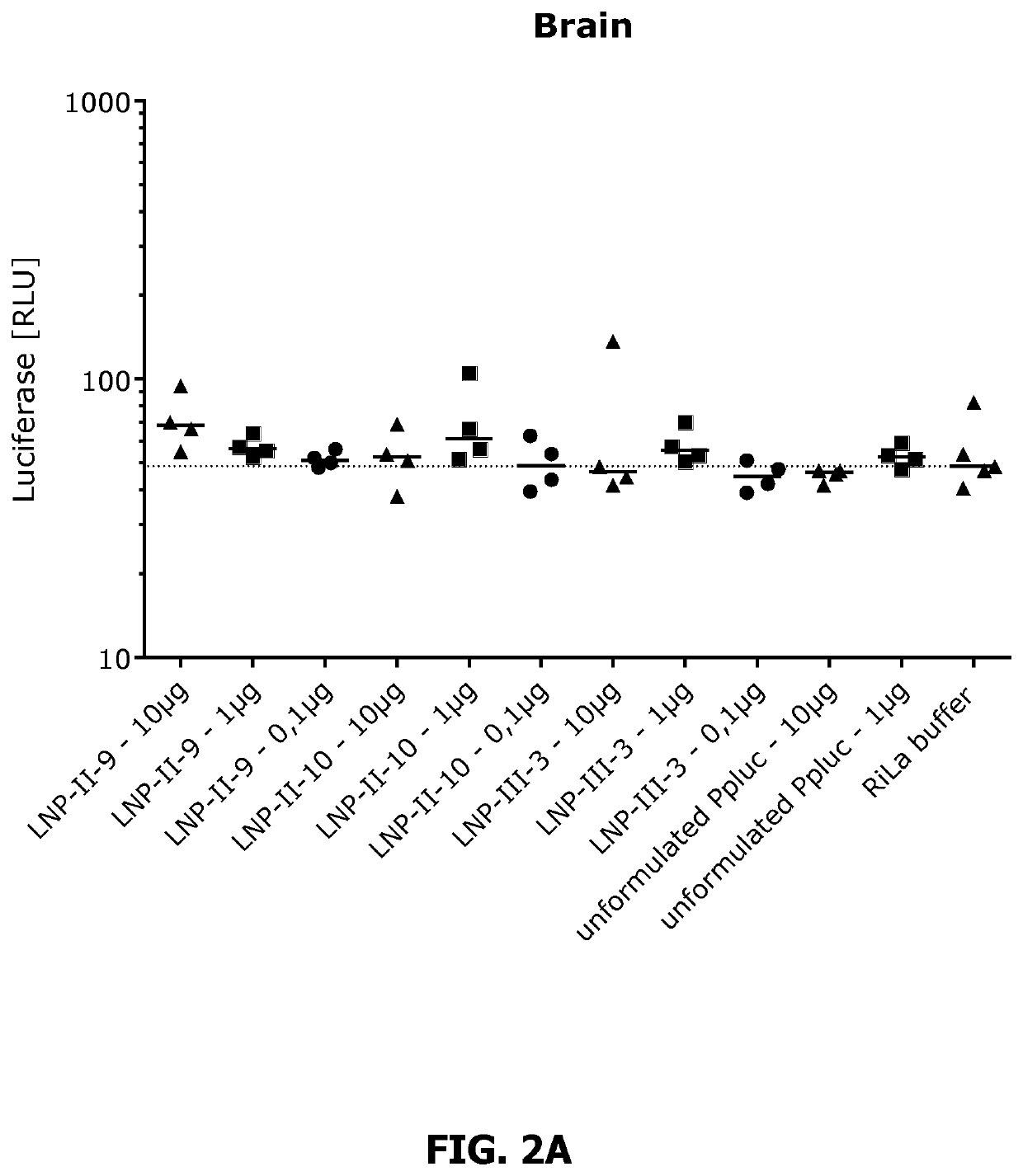Lipid nanoparticle mRNA vaccines
a technology of lipid nanoparticles and vaccines, which is applied in the direction of drug compositions, amide active ingredients, immunological disorders, etc., can solve the problems of pathogens still intrinsically bearing unpredictable risks, the risk of a reversion to life-threatening variants, and the current availability of effective vaccines, so as to facilitate translation or localization and prevent degradation of the rna molecul
- Summary
- Abstract
- Description
- Claims
- Application Information
AI Technical Summary
Benefits of technology
Problems solved by technology
Method used
Image
Examples
example 1
on of mRNA Constructs
[1290]For the present examples, DNA sequences encoding different proteins were prepared and used for subsequent RNA in vitro transcription reactions. The DNA sequences encoding the proteins were prepared by modifying the wild type encoding DNA sequence by introducing a GC-optimized sequence for stabilization. Sequences were introduced into a derived pUC19 vector. For further stabilization and / or increased translation UTR elements were introduced 5′- and / or 3′ of the coding region.
[1291]The following mRNA constructs were used in the examples:
[1292]Photinus pyralis Luciferase:[1293]5′-TOP-UTR derived from 32L4 ribosomal protein-GC-enriched coding sequence encoding PpLuc-3′-UTR derived from albumin gene—a stretch of 64 adenosines—a stretch of 30 cytosines—a histone stem-loop sequence (SEQ ID NO: 224286).
[1294]Influenza Hemagglutinin (HA):[1295]5′-TOP-UTR derived from 32L4 ribosomal protein—GC-enriched coding sequence encoding HA of Influenza A / California / 07 / 2009 (H...
example 2
ression after i.m. Application of LNP-Formulated mRNA
[1315]Expression of luciferase (Ppluc) in BALB / c mice was determined 24h and 48h after intramuscular injection (i.m.) into the M. tibialis.
[1316]Therefore, 0.1 pg, 1 μg and 10 pg mRNA coding for Ppluc were LNP-formulated to yield the respective LNP-formulation according to Table I. As a control served unformulated Ppluc mRNA (10 pg and 1 μg). At time point Oh, four mice per group were transfected with Ppluc mRNA in accordance with the scheme shown in table I.
TABLE I(Example 2): Transfection schememRNAdoseRoute Mice GroupTreatment[μg](Volume)#ALNP-II-9-formulated Ppluc mRNA10i.m. (25 μl)4BLNP-II-9-formulated Ppluc mRNA1i.m. (25 μl)4CLNP-II-9-formulated Ppluc mRNA0.1i.m. (25 μl)4DLNP-II-10-formulated Ppluc mRNA10i.m. (25 μl)4ELNP-II-10-formulated Ppluc mRNA1i.m. (25 μl)4FLNP-II-10-formulated Ppluc mRNA0.1i.m. (25 μl)4GLNP-III-3-formulated Ppluc mRNA10i.m. (25 μl)4HLNP-III-3-formulated Ppluc mRNA1i.m. (25 μl)4ILNP-III-3-formulated Pp...
example 3
icity after Intramuscular (i.m.) Application of LNP-Formulated mRNA
[1321]LNP formulated HA-mRNA was used for testing the immunogenicity after intramuscular (i.m.) application. Specifically, a GC-enriched H1N1 (Netherlands 2009)-HA mRNA sequence as LNP formulation was applied as described above.
[1322]For vaccination, 8 BALB / c mice were intramuscularly injected into the M. tibialis of both legs (25 pl per leg) according to the vaccination scheme shown in Table II. As apparent, 10 pg mRNA encoding Influenza HA was LNP-formulated (as described above) to yield the respective LNP-formulation for vaccination; unformulated mRNA (10 pg) served as a control.
TABLE II(Example 3): Vaccination schemeRNA Mice GroupTreatmentdoseRoute (Volume)#ALNP-II-9-formulated HA mRNA10 μgi.m. 25 μl per leg8BLNP-II-10-formulated HA mRNA10 μgi.m. 25 μl per leg8CLNP-III-3-formulated HA mRNA10 μgi.m. 25 μl per leg8Dunformulated HA mRNA10 μgi.m. 25 μl per leg8ERiLa buffer—i.m. 25 μl per leg8
[1323]On day 0, a prime v...
PUM
| Property | Measurement | Unit |
|---|---|---|
| solubilizing | aaaaa | aaaaa |
| molar ratio | aaaaa | aaaaa |
Abstract
Description
Claims
Application Information
 Login to View More
Login to View More - R&D
- Intellectual Property
- Life Sciences
- Materials
- Tech Scout
- Unparalleled Data Quality
- Higher Quality Content
- 60% Fewer Hallucinations
Browse by: Latest US Patents, China's latest patents, Technical Efficacy Thesaurus, Application Domain, Technology Topic, Popular Technical Reports.
© 2025 PatSnap. All rights reserved.Legal|Privacy policy|Modern Slavery Act Transparency Statement|Sitemap|About US| Contact US: help@patsnap.com



